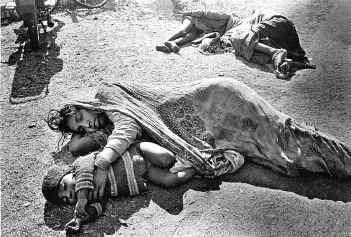
LIE & LET DIE (Part 2)
Union Carbide refuses to share information about their gases involved in the toxic cloud that enveloped Bhopal.
As the scale of death and injury became undeniable, Bhopal’s doctors claimed they were hampered by a lack of medical information from UCC, and were effectively reduced to treating symptoms.(9) For eye problems they used atropine, antibiotics and padding; for swelling, diuretics; and for breathing problems a desperate cocktail of bronchodilators, oxygen, diuretics, steroids and antibiotics.
‘Why hasn’t Union Carbide come forward,’ asked forensic pathologist Dr Heeresh Chandra, quoted in the FT on December 8 1984, ‘…why have they not said “This is the gas that leaked, this is the treatment”? Is it not a moral duty to tell us what was used, what is the treatment, what is the prevention? They have not come forward.’(10)
Twenty Poison Gases
The violence of the exothermic reaction in the Bhopal plant’s huge MIC tank could have spawned up to 200 toxic compounds(11), among them the first world war gas phosgene along with other decomposition products like carbon monoxide and hydrogen cyanide. As much as a third of the materials released may have been created by the explosion itself.(12)
Dr N.R. Bhandari, the Medical Superintendant of Hamidia Hospital, recalls being told at first that the gas was phosgene, then that it was MIC. Later it became clear that it was not only MIC but a mixture of about 20 gases. ‘Immediately after exposure thousands of children and adults died of acute pulmonary oedema, respiratory failure, toxic effects on bodily systems including the central nervous system, congestive heart failure and other complications.’(13)
Knowing what these chemicals were, how they could combine and above all how they affected the body was crucial to the medical effort but from Carbide came no help.
Carbide’s ‘Trade Secrets’
Little was known in India of MIC and its effects and Carbide was still insisting that it was no more than an irritant, a tear gas. Many industry observers in the US were shocked by the company’s callous behaviour. A Senior Vice-President of the US Chemical Institute of Toxicology said that UCC may have conducted its own tests on the long-term effects of MIC but classified its results as ‘trade secrets, which are therefore not available’.(14) A leading chemical journal noted: ‘Union Carbide may have the best information on MIC toxicity around but they’re treating it like a trade secret…’(15) The US chemical industry’s code of conduct calls for information to be given to doctors regardless of whether trade secrets are involved.(16)
A Question of Cyanide
Suspicion that many deaths were caused by cyanide stemmed from weakness, acute syncope and sheer speed of demise.
First autopsies by Dr.Heeresh Chandra at the Gandhi Medical College demonstrated a cherry-red discolouration of blood and organs, and an unpleasant ‘bitter almonds’ odour when the lungs were opened, all typical of cyanide poisoning.(17)
A Telex FromCarbide
As news of the disaster reached America, it prompted an instinctive human response from Carbide’s US Medical Director, Dr Avashia, who dashed off an urgent telex to Bhopal medical authorities: ‘If cyanide is suspected use amyl nitrite; if no effect… use sodium nitrite 0.3gms and thiosulphate 12.5 gms.’(18)
Sodium thiosulphate is a proven antidote for cyanide poisoning. On December 8, German toxicologist Dr Max Daunderer flew to Bhopal with 50,000 ampoules of the drug.
Blood tests performed by Chandra and Daunderer found cyanide at 2 ppm. They confirmed that injections of the antidote led to excretion in urine of high levels of thiocyanate and helped detoxify the body. (19)
With patients showing ‘overall improvement within hours’, a group of local doctors noted that ‘sodium thiosulphate is not at all harmful and could act against many injurious products formed inside the body.’(20)
(A series of double-blind clinical trials made by the Indian Council of Medical Research, ICMR, between 1985 and1987 would later confirm these findings.) (21)
REFERENCES: please see The Bhopal Marathon by following the link below.
You can read the complete Bhopal Marathon publication online here


